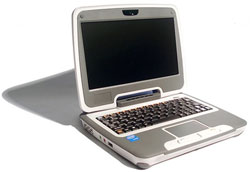Analyst Opinion - Microsoft just released videos of the “Mojave Experiment”, which basically was a survey session aiming to convince a bunch of folks that Windows Vista is not as bad as they may have heard: People with a negative opinion about the software were shown what they thought was the next generation of Windows code-named Mojave. They loved this product and raved about it, only to find they were actually shown Vista. 
This very specific example reminded me of just how good a job Apple and specifically Steve Jobs do with regard to managing perceptions. The current example is the new 3G iPhone, which has a number of serious problems, but people are still lining up to buy. Regardless of how obvious the problems seem to some of us, clearly they are not important to the buyers even though phone battery life, radio performance, and service reliability (where the problems exist) would typically keep a phone from selling well.
But a better example may be how Steve Jobs recently created the perception that he is healthy using a reporter who typically is critical of the company.
It’s all about perceptionBack when I was doing my marketing study work in graduate school, we had an exercise that taught a key lesson. You may recall it as the taste test. And advertisers would use it regularly to showcase that people preferred Pepsi over Coke or one beer over another. So each class, mine being no exception, would do a similar taste test and you quickly concluded that people had no clue what it was they were drinking.
What was also funny was the number of people who had firm opinions that Pepsi or Coke was better ended up choosing the other product. This just points to the fact that people can have firm opinions about even basic subjects that are based on perceptions that are not consistent with reality.
The educated marketer knows this as a fact and the term I use to describe this is that “perception is 100% of reality”, meaning that it generally doesn’t matter what actually is true. It only matters what you and I believe is true. To an experienced marketer like Steve Jobs, this means that he can manipulate our reality and get us to like things we otherwise might not. To the experienced buyer it means we can be manipulated and we often need to pause and assure we are grounded in reality before making a purchase. Any of us, and I include myself (ask my wife about the motorcycle I once bought), can be fooled.
Steve Jobs: Watching a master at workRecently Steve Jobs had a problem in that Apple’s stock price was dropping largely on concerns about his health. He was between a rock and a hard place: If he is sick and admits it, the stock craters and, regardless of his health, if he claims he isn’t sick some won’t believe him and his health will be a constant uncomfortable topic going forward.
So he used his skills to address the problem. If you read
this piece by Joe Nocera of the New York Times, you can actually see Steve’s brain work. (By the way an excellent book on understanding how Steve thinks is
Inside Steve’s Brain).
Rather than calling a loyal reporter like Walter Mossberg of the Wall Street Journal he calls Joe Nocera who has historically been more critical (and thus more credible). Steve Jobs starts by calling Joe some nasty names to make sure there is no basis for loyalty and then asks for that loyalty before disclosing the secret of his health. Joe agrees to hold this information confidential but clearly is not in the mood, thanks to Jobs comments, to follow the letter of that promise. As a result, he credibly certifies that Jobs is healthy while thinking he is actually being critical of the process, which is exactly what Jobs wants him to do. Even if there is an SEC exposure because of insider information (Steve’s health is material to Apple), since Joe breached the confidentiality agreement, Steve may be safe - especially if he denies giving Joe the information that has been reported.
Steve created the impression, very credibly, that he is not critically ill without any connection to any truly credible source and the reporter fills that credibility gap personally. If it isn’t true, Steve just says what he said was in confidence and Joe misunderstood him or says that Joe made it up and, in both cases, it is Joe’s word against Steve’s. And why would Steve share personal and private information with a reporter he doesn’t like rather than one like Mossberg whom he does like? Who would you believe if the two disagreed? The guy known for incredible secrecy or the reporter trying to sell papers?
Brilliantly done. Let’s move to the Vista example.
Windows Vista: Turd or gem?For some time, a number of us who have been using Windows Vista with great success have been listening to others slam the new OS largely for things that were corrected earlier this year. A combination of a lack of benefits-oriented marketing by Microsoft, one of the most disparaging campaigns I’ve ever seen in my life from Apple, and what had been a nasty first year had folks who had never actually seen or touched the product believe that it was, well, crap.
So the folks at Microsoft had a theory they decided to test, similar to the Coke/Pepsi challenge I mentioned above. The strategy was to expose people with a negative opinion of Vista, but who actually never had seen Vista, to Windows Vista’s best features. So they pulled a decent number of them into a focus group setting and showed them Vista, but told them they were actually seeing a product code-named Mojave. At the start they asked folks what they thought of Vista and most seemed to agree with one woman who gave it a “zero”. They were then shown the wonders of a new OS code named Mojave. At the end, after they had been told that what they actually had seen was Vista, most seemed to agree with that same woman who now gave the product a 10. If you’ve never seen a focus group, the videos are kind of interesting to watch.
True, the focus group setting was skewed to showcase what Vista does best. But it was the same product people never would have considered to buy before the test. The only thing that had changed was the perceptions of the people talking about it. Kind of makes you wonder what would happen if Microsoft really marketed Vista, doesn’t it?
Wrapping up: Know your reality
The lesson here isn’t really about Jobs’ health or Windows Vista. It is that our perceptions are often manipulated to our own detriment. Whether it is marketing folks who want to get us to buy what we don’t need (or get us to dislike a product we might otherwise like), or politicians who want us to vote in ways that aren’t in our best interest, we are constantly being manipulated. Knowing that allows us to look for the smoke and mirrors and perhaps be tricked less often. To be tricked less often is my annual, and recurring, personal goal.
Rob Enderle is one of the last Inquiry Analysts. Inquiry Analysts are paid to stay up to date on current events and identify trends and either explain the trends or make suggestions, tactical and strategic, on how to best take advantage of them. Currently he provides his services to most of the major technology and media companies




















 Round Rock (TX) – Dell is offering BIOS updates to mitigate the effects of
Round Rock (TX) – Dell is offering BIOS updates to mitigate the effects of 

 Chicago (IL) - Speculations about possible Zune-branded mobile phone from Microsoft have been discussed in the blogosphere since the iPhone was introduced last June. Microsoft on its part has avoided confirming or denying these rumors (which is usually an indication that such a device is in the works) but analysts warn that the software giant would jeopardize 20 million Windows Mobile licenses if it decided to make the Zune handset.
Chicago (IL) - Speculations about possible Zune-branded mobile phone from Microsoft have been discussed in the blogosphere since the iPhone was introduced last June. Microsoft on its part has avoided confirming or denying these rumors (which is usually an indication that such a device is in the works) but analysts warn that the software giant would jeopardize 20 million Windows Mobile licenses if it decided to make the Zune handset.










 According to a
According to a 


